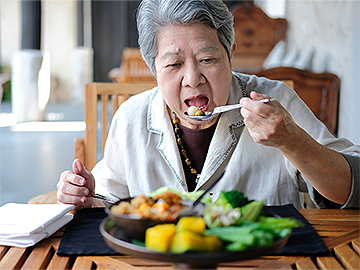Food for Thought: Factors That Go Into Developing a Menu for Dementia Care
Devra Shiba, a dietitian and certified dementia practitioner, has a unique and dynamic job. As one of four senior managers in clinical area support for Sodexo, one of her main responsibilities is thinking about how to make the lives of seniors better. Her team also works on hiring and onboarding dietitians and foodservice managers. They are the menu gurus for the company, making sure recipes are nutritionally sound and meet the needs of the older adult population in senior care facilities.
 One of Shiba’s areas of expertise is dementia care through menu development, a pillar of Sodexo’s B Integrated Dining and Therapeutic Hospitality™, holistic assisted dining solutions that incorporates nutrition, wellness and hospitality for residents experiencing early symptoms of cognitive impairment. “There are specific needs for residents who have dementia, and as the dementia progresses, there are certain cognitive functions that are affected,” she says. So when it comes to menu development, it’s not just what’s on the plate that she considers; it’s everything in the environment, including the noise level, table arrangement, how the silverware and plates are placed, or the glare from the window that can interfere with residents’ ability to see what’s at the table.
One of Shiba’s areas of expertise is dementia care through menu development, a pillar of Sodexo’s B Integrated Dining and Therapeutic Hospitality™, holistic assisted dining solutions that incorporates nutrition, wellness and hospitality for residents experiencing early symptoms of cognitive impairment. “There are specific needs for residents who have dementia, and as the dementia progresses, there are certain cognitive functions that are affected,” she says. So when it comes to menu development, it’s not just what’s on the plate that she considers; it’s everything in the environment, including the noise level, table arrangement, how the silverware and plates are placed, or the glare from the window that can interfere with residents’ ability to see what’s at the table.
"With visual impairment, it becomes a little harder to define where the rim of a plate is, so having a white dish on top of a white tablecloth makes it hard to see where the plate ends. One of the things we do is recommend that they have colored plates, Shiba explains.
As dementia progresses, a resident may not understand what a fork, spoon and a knife are for, so they begin to use their hands. Keeping this in mind, Shiba and her team develop menus that feature handheld food items. Even if some residents can’t sit at the table for a long time and have the need to get up and wander around, they can still hold these foods in their hands. Texture is another factor — whether the resident has the ability to eat crunchy foods, or if they need softer types of food.
As dementia progresses, a resident may not understand what a fork, spoon and a knife are for, so they begin to use their hands. Keeping this in mind, Shiba and her team develop menus that feature handheld food items. Even if some residents can’t sit at the table for a long time and have the need to get up and wander around, they can still hold these foods in their hands. Texture is another factor — whether the resident has the ability to eat crunchy foods, or if they need softer types of food.
 The most important aspect of these menus is the nutritional content, Shiba says. The standard for dementia care is the MIND diet, which combines aspects of two popular diets, the Mediterranean diet and the DASH (Dietary Approaches to Stop Hypertension) diet. The foods that are in these recipes have also been proven to have a number of other health benefits, such as protecting eyesight and lowering the risk of developing certain types of cancers and reducing the chance of strokes.
The most important aspect of these menus is the nutritional content, Shiba says. The standard for dementia care is the MIND diet, which combines aspects of two popular diets, the Mediterranean diet and the DASH (Dietary Approaches to Stop Hypertension) diet. The foods that are in these recipes have also been proven to have a number of other health benefits, such as protecting eyesight and lowering the risk of developing certain types of cancers and reducing the chance of strokes.
"We have developed a whole line of healthy foods that would be part of the MIND diet — foods that support brain health like berries, because we know that berries lower the risk of inflammation. So they may have berries, or dark chocolate, or a lot of vitamin D-type foods to increase brain health. Omega-3 fatty acids are another thing that we've looked at to put in our foods. We also know that people who eat more seafood have reduced rates of decline in memory, so we're looking to offer these foods not only in our dementia units, but throughout the continuum of independent living and assisted living, where maybe we'll have a chance of helping the brain to stay healthier", Shiba says .
Learn more about our Memory Care Dining program and B Integrated Dining and Therapeutic Hospitality™ program.